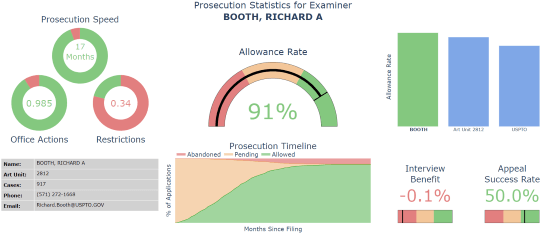What are Patent Examiner and Art Unit Statistics?
In an effort to provide greater transparency to the patent application process, and to help patent practitioners develop data-driven prosecution strategies, IronCrow AI has compiled prosecution statistics for all 10,000+ patent Examiners and 500+ art units, and is making this information freely accessible. These statistics capture the previous prosecution behavior of Examiners and art units, and are presented as comprehensive, multi-tab dashboards with interactive visualizations, detailed application data, appeals analysis, and strategic recommendations.

Why Use Examiner Statistics?
- Find an Efficient Path to Allowance: Should you amend claims aggressively, or would an Examiner interview be enough to get your claims to allowance? Our statistics help answer these questions, enabling you to develop a prosecution strategy based on data instead of trial-and-error.
- Align Client Expectations: Establish realistic client expectations for the duration and difficulty of getting claims to allowance, based on the particular Examiner and art unit to which their application has been assigned.
- Reduce Prosecution Costs: Avoiding unnecessary or unhelpful actions during prosecution, such as foregoing an interview with an Examiner who is MORE likely to reject claims after an interview, may help you reach allowance faster, and with less expense.
- Strategic Appeals Guidance: Understand when filing an appeal is likely to be effective, and whether pre-appeal conferences or appeal briefs have historically led to favorable outcomes with specific examiners.
How to Find Stats for an Examiner or Art Unit?
Simply start typing the name of a patent Examiner or the number of an art unit in the search bar above, and a drop-down list of all matching Examiners/art units will appear. Examiners are uniquely identified by a string in the format "ART UNIT-LAST NAME-FIRST NAME-MIDDLE INITIAL". As an example, Examiner Ayaan A. Alam in art unit 1611 is uniquely identified by "1611-ALAM-AYAAN-A", whereas art unit 1611 is identified by "1611".
What Information is Provided?
Each examiner and art unit page includes four comprehensive tabs:
Dashboard Tab:
- Allowance Rate: The percentage of all applications under a given Examiner or art unit which are eventually allowed.
- Allowance Rate Comparison: A bar chart showing the allowance rate of a given Examiner/art unit relative to other organizational units within the USPTO.
- Prosecution Timeline: A timeline showing how the population of pending applications under a given Examiner or art unit evolves over time (e.g., by being allowed or abandoned).
- Prosecution Speed: Estimates the amount of time between filing an application and reaching final disposition under a particular Examiner or art unit. Equivalent to the half life of a pending application.
- Office Actions: The total number of Office Actions issued by an Examiner or art unit divided by the total number of applications processed by that Examiner/art unit, can be thought of as the likely number of Office Actions issued for an application before a final disposition is reached.
- Restrictions: The total number of restriction requirements issued by an Examiner or art unit divided by the total number of applications processed by that Examiner/art unit. Equivalent to the probability of receiving a restriction requirement.
- Interview Benefit: The allowance rate for applications in which at least one Examiner interview is conducted minus the allowance rate for applications in which no Examiner interview is conducted.
Recent Applications Tab:
- Detailed table of the 100 most recent applications examined, including filing date, disposition, office actions, restrictions, interview status, appeal status, and time to disposition.
- Sortable columns allow you to analyze patterns across applications.
- Direct links to USPTO Patent Center for each application.
Appeals Analysis Tab:
- PTAB Decision Statistics: The percentage of PTAB decisions in which the Examiner or art unit is reversed, with comparative percentile rankings.
- Appeal Filing Benefit: The percentage of cases where filing an appeal leads to allowance (with or without the appeal proceeding to a PTAB decision), indicating if simply filing an appeal helps reach allowance.
- Strategic Recommendations: Data-driven guidance on when appeals are likely to be effective based on historical patterns.
Summary Report Tab:
- Comprehensive written analysis of prosecution patterns and strategic recommendations.
- Detailed guidance on interview effectiveness, RCE strategy, after-final amendments, pre-appeal conferences, and petition practice.
- Percentile-based comparisons showing how the examiner or art unit compares to USPTO averages.
- MPEP references for relevant prosecution procedures.
Our Philosophy for Patent Prosecution Metrics
Our goal is to provide insight into the previous prosecution behavior of every Examiner and art unit in the USPTO, while encoding as few assumptions as possible. We also understand that each patent practitioner, and patent application is different, and therefore the importance of the various Examiner metrics will change depending on the situation. To that end, we avoid giving Examiners an overall "grade" using a home-brewed formula, but instead present comprehensive prosecution metrics in an intuitive, multi-tab format, allowing you to make your own informed decisions based on the data most relevant to your specific situation.